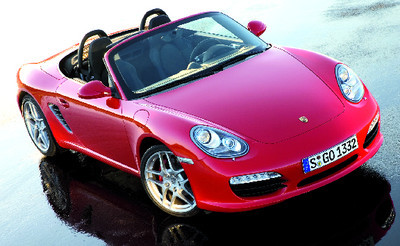Porsche refits Boxster

Incremental gain is what Porsche is all about.
It’s not that the company is afraid to make big change. No, the fact is that its cars are already great, requiring honing rather than wholesale makeovers to stay ahead of the curve. Welcome to life on the razor’s edge.
Take a good look at the 2010 Boxster roadster. Kinda-sorta looks like the old one, doesn’t it? Of course it does, despite the fact the car has received expensive and not necessarily obvious changes under its skin.
Porsche is averse to design obsolescence and has been since the company’s humble beginnings back in the late 1940s. For proof, consider the 911, the midengine Boxster’s bigger and more powerful rear-engine relation. Although undergoing numerous upgrades since launching in 1965, the car’s fundamental proportions have remained basically unaltered since that time.
The 2010 Boxster, along with the similarly shaped Cayman hardtop, appear to be heading down that same winding road. For the record, the Boxster’s nose and tail have been reshaped and given new headlamps and taillights, with the latter converted to faster-reacting LED illumination. As well, a wide-mouth air intake has been carved out below the front bumper. Still, current owners will be reassured that their Boxsters will appear closely identical to the newest version, although newer and bigger rim designs will somewhat differentiate the 2010 model.
The convertible’s interior retains its familiar look with comfortable seats and surroundings, but the standard sound system has been augmented with a 5-inch display screen and the unit can now play CDs as well as MP3 computer files.
Elsewhere, significant albeit unseen changes should add luster to the Boxster’s reputation as one of the most competent sports cars around. A newly fortified suspension and steering package has been designed for improved ride and driving characteristics. As well, the stability-control system, which helps prevent a skid or spin, will now preload the brakes when the accelerator pedal is suddenly released (indicative of an emergency-stopping situation) by moving the pads closer to the discs to reduce stopping distances. The system also features Brake Assistant, a program that supplies additional force during emergency stops.
When not standing on the binders, Boxster drivers will appreciate the added punch of the new 255-horsepower 2.9-liter horizontally opposed six-cylinder powerplant, a gain of 10 over last year’s 245-horsepower 2.7-liter unit.
Choose the Boxster S and you’ll be wheeling and dealing with a 3.4-liter six-cylinder that produces 310 horsepower, 15 more than the previous 3.4-liter engine. The extra power is due to the use of direct-fuel-injection technology that sprays fuel straight into the combustion chambers instead of the ports of the intake manifold.
Both base and S vehicles come with a six-speed manual transmission, while a new seven-speed automated manual gearbox, called Porsche-Doppelkupplungsgetriebe, or PDK (thankfully), replaces the previous six-speed Tiptronic automatic. The paddle-shifted PDK not only lops a couple of tenths of a second off the six-speed-manual Boxster’s zero-to-60-mph time, but also reduces overall fuel consumption by as much as 16 percent.
Additional performance is available with the PDK when the optional Sports Chrono package is added. This includes Launch Control that allows the driver to floor the accelerator while keeping the left foot on the brakes. With the engine revs held to 6,500 rpm, releasing the brakes is good for an additional (around 0.3 seconds) reduction to 60 mph, resulting in a sub-5.0-second run for the Boxster S.
Of course, all of these technological upgrades are offered at a steep increase in base price. But if you can restrain yourself, a base Boxster will run about $50,000, while the S will take an extra $10,000 to acquire.
For the money, your new Boxster won’t look much different than before, but performance and engineering improvements alone represent true Porsche-style progress.